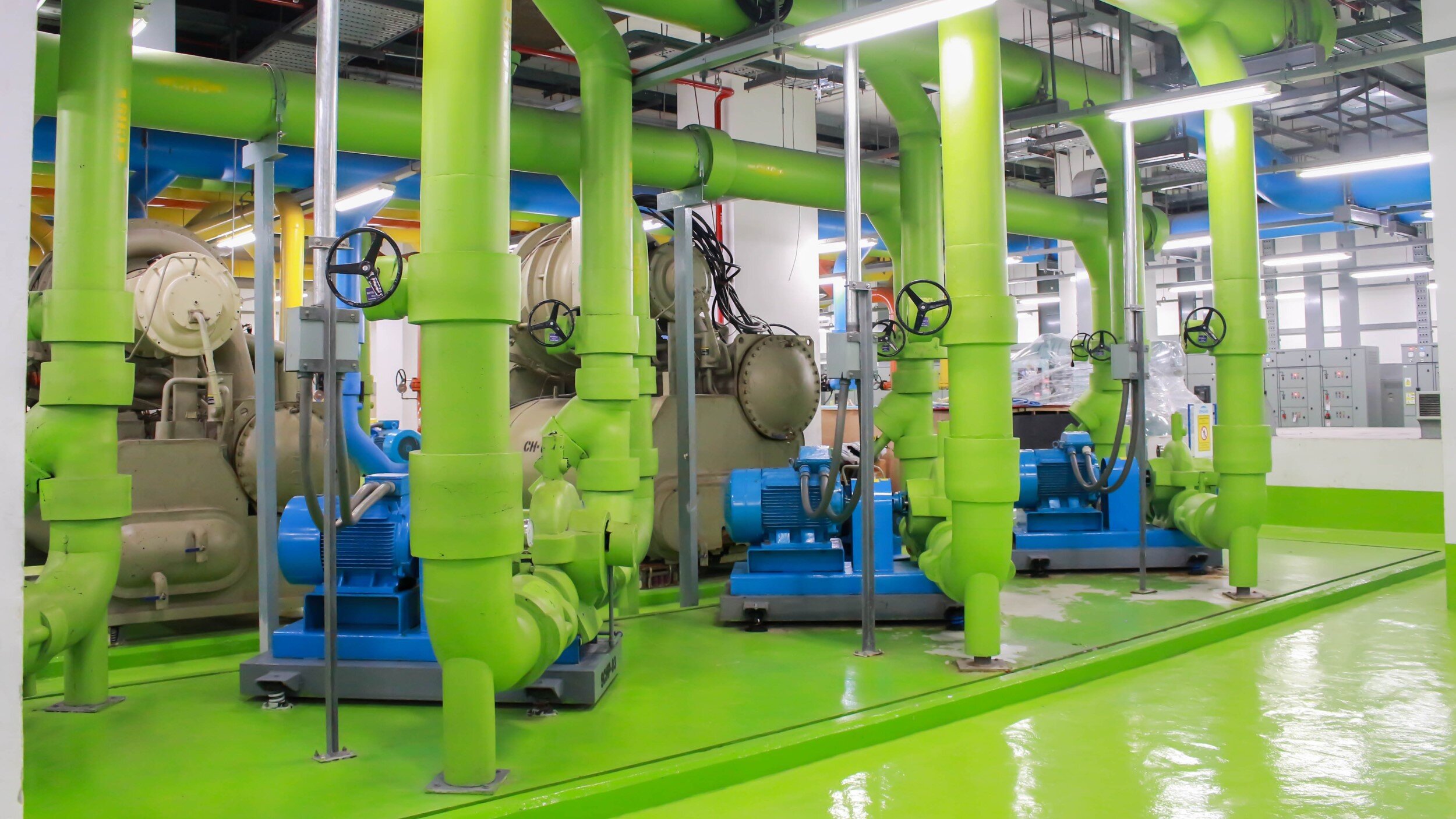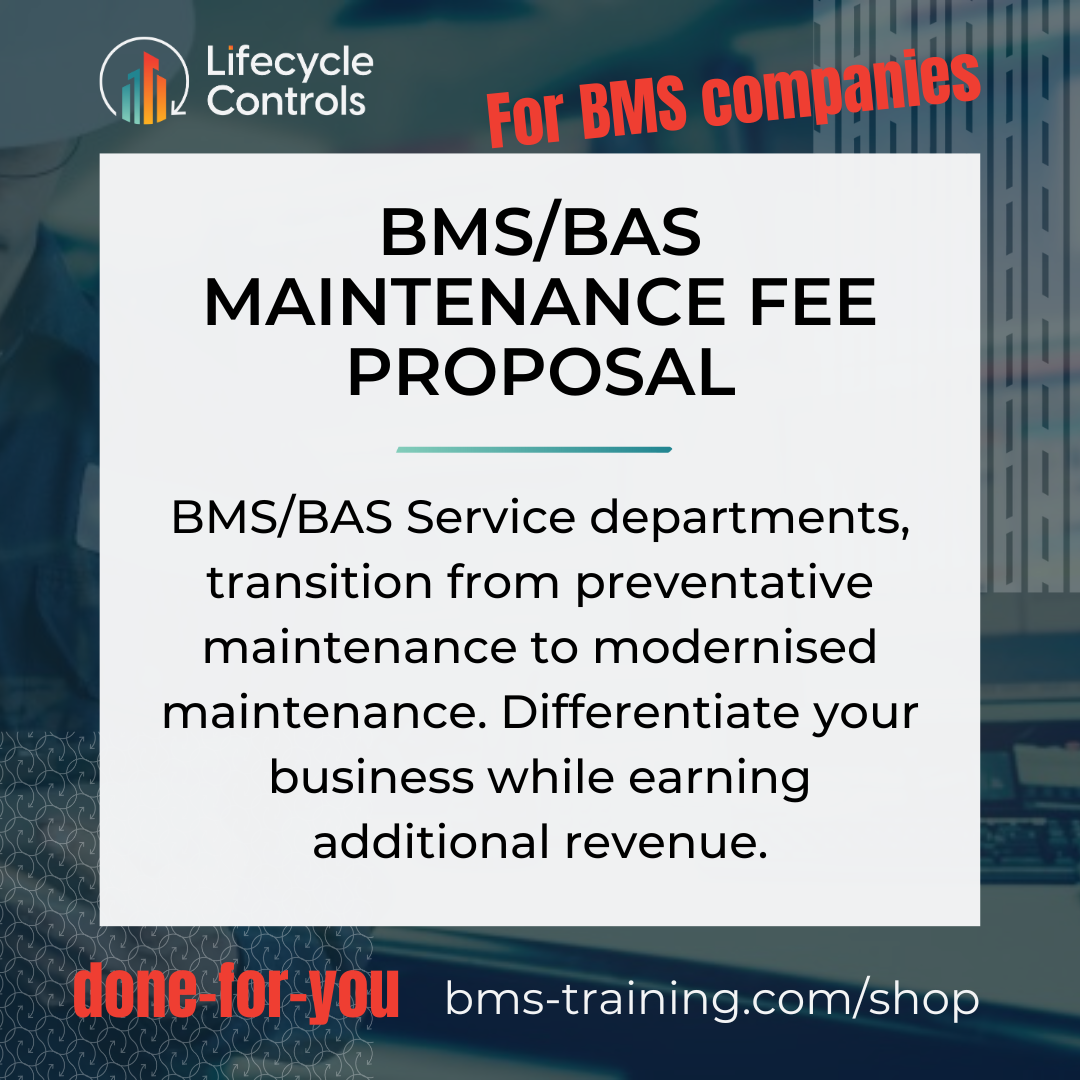Chiller Minimum Evaporator Bypass Control
On almost every project I work on, or peer review, the chiller bypass control is either wrong or ends up causing issues down the track, resulting in chillers tripping during low load conditions or energy wastage.
This discussion is specific to variable primary pumping and not primary/secondary pumping systems.
Before we start, the bypass valve modulates to maintain chiller minimum flow, and the pumps speed modulates to maintain system pressure, and not the other way around. This discussion focuses only on chiller minimum evaporator control and not the chiller control system as a whole as this would be too much to cover in a blog.
Where does it go wrong?
Commissioning:
The mechanical commissioning technician sets up the chilled water system for full design flow. All field chilled water valves 100% open, bypass valve fully closed, all lead/lag chiller primary pumps running at design volume.
The BMS commissioning technician checks all the chilled water system inputs and outputs and then walks over to the chiller commission tech and asks: ‘What is the chiller flow set point for the bypass control valve?’, and this is when it starts to fall apart. The chiller tech confirms a value a few kPa above the chiller cut-out flow switch setting.
The problem is that the chiller tech often sets up the cut-out flow switch a safe value below the design flow. In my experience, mechanical chiller commissioning is entirely focused on design flow conditions and not variable flow or minimum flow. The chiller commission tech is only interested in the chiller, not the system as a whole. Over the years the cut-out setting has lowered, but often no where near low enough to realise the full turn down of the chiller.
So we end up with a variable primary pumping system that is pretty much constant volume. E.g. design flow is 71 L/s and bypass control is 60 L/s, where the chiller could reduce down to 45 L/s in low load.
The whole point of moving away from 3-port control valves in the field to 2-port control valves was to slow down the primary pumps and save energy when not in a design condition (outside air temperature above 35°C).
Incorrect evaporator pressure transmitter selection
The worst case scenario is when two pressure transmitters of the same range are selected for system pressure measurement and chiller evaporator pressure measurement. Lets say 0-250 kPa. Well, that may be okay for system pressure, but the bypass control set point could be around 23 kPa, so the 0-10 Vdc controller analog input is trying to measure an input signal around 1 Vdc. Sensor ranges should be selected to control the process variable ideally around 5 Vdc (mid range). Generally, sensors are less accurate, reliable and repeatable at the bottom end of their sensing range.
Even when not selected at the worst case scenario, the chiller evaporator pressure sensors are always selected for the chiller design flow. If the chiller design flow is 51 kPa, we will probably end up with a sensor with a range of 100 kPa depending on the next available size up. This is still not great for a set point of 23 kPa.
We should be selecting the pressure sensor with a range of approximately 0-50 kPa, to ensure good control in low load conditions when the bypass control loop is enabled. Accurate, reliable measurement at design flow is pointless. Accurate, reliable measurement at the chillers minimum flow rate is the objective.
Incorrect PID control parameters
I don’t know if this is due to lack of training, tuning or reduced available commission time, but I almost always find this to be a significant contributing factor when investigating chiller tripping issues.
I tend to see really wide proportional band settings for bypass control. Maybe the software programmer is pasting the same PID module that is being used everywhere else?
We end up with a bypass proportional band of say 10 kPa. Therefore, if the bypass set point is 23 kPa, then the bypass valve will be 100% open only once the flow has reduced to 13 kPa, in this example the cutout flow switch interlock for the chiller was set to 19 kPa. The problem is compounded in that the bypass valve takes around 90 seconds to fully open and the sensor is reading approximately 2 Vdc of its 0-10 Vdc range, best case scenario, or 0.7 Vdc worst case (most likely) as we are approaching the cutout safely interlock. I.e. the chiller is almost definitely going to trip on low flow.
We probably should be using flow meters
Differential pressure transmitters across the chiller evaporator are probably not ideal when you have aggressive variable primary flow, as we have in Australia. If you have high energy efficiency targets you need to start looking at providing magnetic flow meters on chillers. They are not that expensive anymore, especially when considering the amount of time spent messing around with a poor input reading to a critical control loop.
And when we can’t get it right, we tend to increase the minimum flow bypass control valve set point, resulting in wasted energy for the next 15-20 years.
Butterfly valves used for chiller minimum flow control
Butterfly valves should be used for isolation only and not for control. They have a quick opening flow characteristic which is not suitable for control especially for something as sensitive as minimum evaporator flow control. I think they find their way into bypass control because a 250mm globe valve plus linear actuator is extremely expensive. Rather than provide a butterfly valve that is never going to work (with aggressive energy saving variable pumping), rather discuss with the mechanical engineer if we really need a bypass designed for the chillers design flow (which we don’t because we have VSD’s) or get two smaller bypass lines provided in parallel.
Bypass valve controlling system pressure
I still see this a couple of times a year: the pump speed controlling chiller flow and the bypass valve controlling system pressure. It appears to work but always.
As the the load starts to reduce, the AHU 2-port control valves start to close off, resulting in an increase in system pressure. The bypass control valve then modulates opens to maintain system pressure. A secondary effect of the bypass control valve opening to maintain system pressure is that more water gets bypassed back through the chiller, so it’s indirectly assisting in maintaining minimum evaporator flow.
Keep in mind, the last thing we want to do is open the bypass valve; it wastes energy.
Now remember, the chilled water system is hydraulically balanced in a full load condition, not a low load condition. At some point as those 2-port control valves are closing off, the system pressure increasing and the bypass valve opening to maintaining system pressure, we will get to a point where we start approaching the chiller cut-out set point. So, we start speeding up the pump to maintain the chiller minimum flow set point.
And then the chiller trips.
Increasing the speed of the pump, with the bypass valve fixed in some position (maintaining system pressure), will not increase the flow through the chiller. We can run the pump as fast as we like, up to 100%, it makes no difference, the water has no where to go. Unless you open the bypass valve more, ramping up the pump speed to 100% will not increase the flow through the chiller.
System start-up or stage-up
When the system stages up to the next available chiller, and another pump is started, the currently running chiller will likely be starved of water and trip on low flow. Now you have your lead chiller failed and on a 15-minute recycle timer before restarting, and the lag chiller loading up but now trying to take up all the load on its own. I.e. we just lost conditions.
The most common strategy is to fully open the bypass control valve on stage up. This is well known, but does still occasionally get forgotten.
I have started moving away from simply fully opening the bypass valve on stage up as it can cause other issues, e.g.
Starving the field of chilled water during the stage up sequence. It’s more noticeable when the bypass line size is oversized and more of an issue with critical applications like data centers where a temporary increase in chilled water supply temperature is more noticeable.
Significant volume of supply chilled water (6°C), mixing with the return water back to the chiller, preventing the lag chiller from loading up. Some chillers will not load up if the return water temperature is less than say 12°C. So that additional chiller that we needed, is now waiting for the return water to increases, while we have the bypass valve fully open and a failed lead chiller.
The bypass pipe diameter between the common flow and return should be sized for the chiller minimum flow (in my opinion), but it is often sized for chiller design flow. The bypass pipe diameter size is debatable, however, the point I am making is that a fully open bypass valve could possibly be too much water.
Rather than fully opening the bypass valve on stage up, I override the bypass minimum flow set point up to perhaps the design value. This performs a similar concept to fully opening the bypass valve, just in a more controlled manner, it assists in not overflowing the chiller and is tuneable.
Value engineering
In Australia what the consultant specifies doesn’t always get implemented. More often than not the low load chiller gets value engineered out and replaced with a buffer tank. This significantly increases the chances of the lead chiller (high load) tripping on low flow during low load conditions. So, we need to work a lot harder on our bypass control.
Conclusion
When you have chillers occasionally tripping during low load conditions, it can be difficult to diagnose. Sometimes it isn’t the result of any one of the above points, but a combination of all components slightly under performing. The easy fix is to increase the bypass minimum flow set point to create a larger buffer before reaching the chiller safety cut-out, this is a significant compromise in energy efficiency, and in my opinion not acceptable.
Fixing the issue from the start doesn’t cost more money, it just needs a robust design and engineering.
Chiller design parameters used in this example
Chiller design flow: 71 L/s at 51 kPa - VSD 33Hz
Chiller minimum flow set point (bypass): 45 L/s at 23 kPa - VSD 27Hz
Chiller cutout: 40 L/s at 19 kPa - VSD 19Hz
Featured - Latest published online course
BMS for mechanical consultants course
This course was developed by a BMS consultant for mechanical consultants involved in Building Management System projects. Learn how to reduce risk to your company, your client, and the BMS contractor.
Self-paced online course.
12 hours of video lessons.
Training manual (+90 pages).
BMS design examples.
A sample of Lifecycle Controls BMS specification clauses are provided to assist with learning. You can use these in your own specification.
Online shop
Free control strategy mini courses
Create a free account in our Learning Management System and complete the free chilled water control system mini-course. A certificate is provided at the end of the course. A copy of the control strategy is provided as a Microsoft Word document for you to modify in your own BMS designs.
Please join our newsletter
To be notified when new courses, design templates, and digital products are published.
For updates to coaching availability.
For updates to business-to-business consulting services.
New Youtube video releases and occasional updates on what I am up to.
I will not fill up your inbox with crap.
Bryce Anderson
I am an independent Building Management System consultant based in Australia. I started in the BMS industry in 1998 and initially worked for BMS companies for the first 15 years of my career (2 years in South Africa, 9 years in London, and 4 years in Melbourne). In 2014 I transitioned into BMS consulting, saw a massive gap in the lack of specialist BMS consulting, and started Lifecycle Controls in 2017.
My focus is currently on BMS technical training, coaching, and B2B consulting for BMS companies and mechanical consultancies. Because, fixing one project at a time was making no difference. Training thousands of engineers will :-)





































